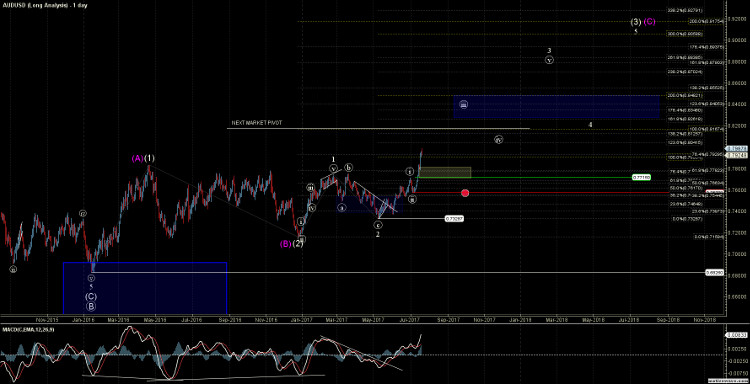If the AUD/USD can break through that 0.8167 pivot level while holding over the support zone, it could see at least the 0.8261-0.8482 target zone later this year and higher into 2018, says Mike Golembesky, an Elliott Wave analyst who covers forex.
I have written several articles discussing my long-term prospects for the Australian dollar against the U.S. dollar over the past 6 months. In February, I had written that there was likely a multi-year low in place on the Australian dollar/U.S. dollar (AUD/USD), and then on May 2 I followed up writing that there was now a longer-term trade setup in place on the AUD/USD.
At the time of the May article the Australian dollar was trading at 0.7550 against the US dollar and I had noted that:
“From a trading perspective, this current pattern is providing us with a fairly clean long setup around current levels with stops just under the 0.7159 zone. Targets for this longer-term trade setup come in at the 0.8372-0.8593 zone.”
On May 9, the AUD/USD bottomed at 0.7328 and as of July 19 is trading 8% higher off of that May low.
The AUD/USD has now strongly broken through several price levels that have now given us the initial signals that the pair is indeed following through on this longer-term trade setup that had been laid out back in May.
I have also recently written about how the pundits seem to always find some exogenous news item to explain the price movements in the financial instrument in which they are reporting on. Often times the connection between this exogenous event and the financial instrument is suspect, and other times it’s just down right absurd.
There are times, however, when the exogenous news event can be more closely associated with a move in the financial instrument, at least from the perspective of the traditional theory of macroeconomics. The problem is that often times the reaction that the financial instrument took was in opposition to what the traditional macroeconomic theory stated that it should have been. In those cases, there is typically a myriad of excuses that economists and pundits come up with to explain why things did not go as expected. Many center around how the market just got things wrong this time.
Finally, we have situations such as the one that had occurred with the release of the meeting minutes from the Reserve Bank of Australia this week. It was an exogenous news event that was more closely associated with a move in a financial instrument but there was nothing of real substance stated in that news event.
Earlier this week immediately following the release of the meeting minutes from the RBA’s policy meeting, the AUD/USD moved sharply higher. So, under the widely accepted theory that higher interest rates help a country’s currency appreciate in value, then one may have come to the conclusion that the RBA had either raised interest rates, or at least very explicitly laid out a plan to do so in a way in which the broad consensus view amongst traders was that a rate increase was surely on the way.
Well, this is not quite what we saw this week after the RBA meeting minutes were released.
Here are some of the headlines that came out after the minutes were released:
Australian Dollar keeps gaining despite RBA minutes’ worries
Aussie dollar jumps on hints RBA may turn hawkish
Australian dollar soars to two-year high on RBA minutes
RBA July meeting minutes recap - upbeat comments help AUD higher
Market minds split over intent behind RBA neutral rate disclosure
The headlines alone point to the fact that there was hardly a consensus view on whether the meeting minutes were indeed hawkish or bearish, signaling a rate increase or not. And the commentary by the analysts and economists interviewed within in those articles is equally as mixed.
Furthermore, if you took the time to read the full minutes of that meeting, you could find some areas of the meeting which could be construed as positive and others that could be negative.
Of course, since a sharp spike up in the AUD/USD should have been caused by a hawkish RBA, we saw several headlines state as such. This, even though there was no broad consensus amongst anyone that the RBA was indeed signaling a hawkish view.
It was simply a matter of those pundits putting a hawkish spin on an otherwise ambiguous meeting based on what had occurred in the market after the minutes of that meeting were released.
So for those pundits who did insist on putting a hawkish spin on the meeting minutes from the RBA, a much more accurate way to have stated that view would have been to have used a headline like I chose for this article.
As noted above, after bottoming at the 0.7328 level in May 2017, the AUD/USD has moved sharply higher. The pair is now trading over the April high and has broken through several key resistance levels and is following through on the pattern that I had laid out in the spring of this year quite well at this time.
The key support levels currently reside at the 0.7807-0.7717 and as long as the AUD/USD holds over that support zone then the next key pivot level for the AUD/USD comes in at the 0.8167 level.
If the AUD/USD can break through that 0.8167 pivot level while holding over the support zone noted, then it is on track to see at least the 0.8261-0.8482 target zone in the later part of this year and likely will see much higher into 2018 and beyond.
See charts illustrating the wave counts on the AUD/USD.






















